While always challenging, change can be a major growth catalyst, just so long as you know how to approach it and the factors influencing it
Words by Karan Karayi
Even at the best of times, leading an organisation can resemble something of a high-wire act crossed with juggling multiple balls in the air at once, given the fine lines that have to be trodden while balancing multiple priorities. And that’s before you even begin considering the volatility of tackling economic slowdowns, surging inflation, and geopolitical disruptions dotting the global landscape.
While addressing more short-term challenges remains a vexing issue, there are certain long-term issues that have been equally concerning, such as keeping costs in check, managing the entire value chain, balancing the needs of the workforce with that of the organisation. Tackling these transitions calls for clarity of though and decisive action, not just for organisational success, but to ensure broader well-being; with approximately 3.3 billion of our planet’s 8 billion populace employed by an organisation in some capacity, organisations and leaders wield the ability to shape society itself.
That said, let us pinpoint some factors that are influencing change at scale. Challenging though they may be, they also represent an opportunity to win critical battles on the morrow.
Building speed and resilience
By now, organisations and leaders need to understand the criticality of responding to fast-changing speed with alacrity. Yet, you’d be surprised at how unprepared some might be. While more than 60% of respondents in McKinsey’s State of Organisations Survey believe that organisational resilience will only grow in importance, half believed that their organisation is unprepared to react to future shocks.
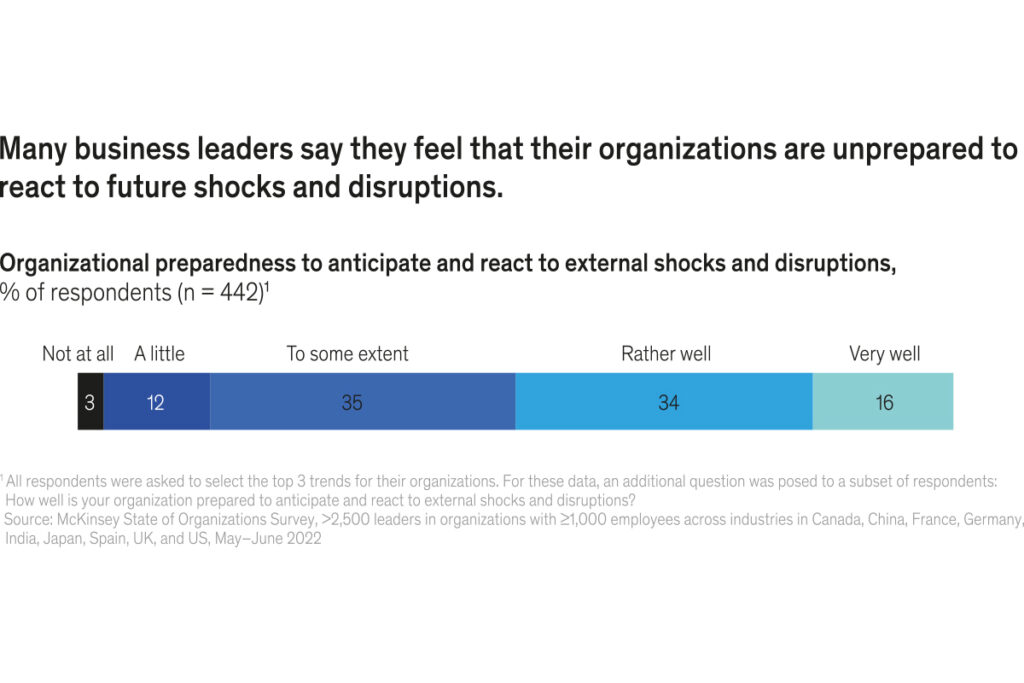
There is value to be gleaned from being able to rise to the occasion, often significantly so; in the 2020–21 economic recovery, companies that demonstrated resilience generated 50% more Total Shareholder Return (TSR) than their peers that were less resilient in nature. This only serves to further underline the need to focus on being prepared to respond swiftly to challenges that are now the norm, not the exception.
However, readying a more resilient organisation calls for more than just anticipating challenges some way off in the distance. It requires a more holistic approach of future-proofing organisational structures and processes, and developing a culture of continuous learning among personnel, so that they are equipped with the tools and knowledge needed to land on their feet unscathed if the ground below them were to give way.
The reality of hybrid work

One of the biggest changes to emerge is the rise of the hybrid workplace. And for a growing cross-section of the workforce, it is a critical differentiator when selecting their next employer. Hence, by remaining open to a reset of the workplace as we know it, organisations can draw the choicest of talent to its flock.
It’s quite remarkable how things have changed on this front. Pre-pandemic, organisations expected four out of five employees to bide their time in the office. Today, that number has dropped to 1 in 5, with the rest allowed to work in a hybrid environment that fits their role and goals. Needless to say, this is a move that has been welcomed, with those that have experienced it reluctant to go back to the ‘Old Normal’ since the hybrid workplace offers a greater degree of flexibility and balance.
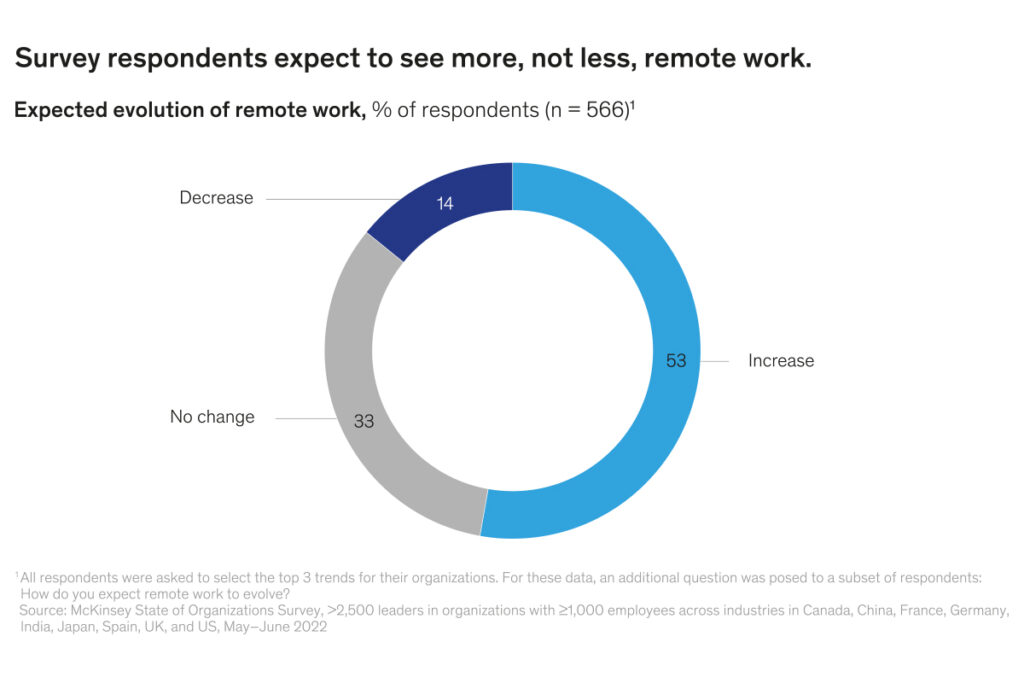
Unsurprisingly, 90% of companies have embraced this new model, creating a structure and support system that helps the organisational machinery turn smoothly, be it in a physical or virtual scenario.
There is no one-size-fits-all solution for the how, where, and when of hybrid work, though; each organisation will have to work out how to do so in a manner that suits its goals and workforce, with policies, workflows, and documentation that supports the creation of an aspirational workplace.
The rise of AI
Unless you’ve been living under a rock, you’ve probably heard about the rise of several AI-enabled innovations that promise to change industry and society for the better. From an organisational perspective, AI can help create an always available, long-term talent pipeline, improve the nature of work, and streamline processes in ways previously unimaginable.
Organisations across the world have been quick to realise AI’s possible upsides, with more than half of the respondents in a McKinsey Global Survey on AI saying they have adopted AI in at least one of their business units, and nearly two-thirds expected that their companies’ investments in AI would increase over the next few years. By adding a layer of intelligence, AI can not just add speed at scale, but also help manage personnel and processes optimally.
But the road to this promised land is paved with challenges, the first being the innately human trait of being resistant to change. And what if the leaders themselves aren’t AI savvy, or if there are capability gaps across the length and breadth of the organisation that need to be addressed before we embed AI into it? Plugging any of these lacunae are vital to correctly deploying AI, and unlocking organisational performance.
The talent tug–of-war
There has been something of a silent redrawing of the lines when it comes to our attitudes towards the workplace. We saw a phenomenon dubbed ‘The Great Attrition’ emerge last year, where talent migrated en masse in search of either more money, work–life balance, professional development, purpose, or a combination of these factors.
This is a pressing concern for modern-day organisations; according to McKinsey research conducted between 2021 and 2022, 33% of employees across nine countries in Europe, 40% of employees in the United States, 45% of employees in the Middle East, and 60% of employees in India were planning to leave their jobs. 2023 has not seen any change in those sentiments either, with a LinkedIn report saying that 88% of young professionals aged 18-24 on the lookout for new roles, a number that drops to 64% for professionals aged 45-54. Just 14% of those polled in McKinsey’s State of Organisations Survey felt that this churn would reduce in 2023.
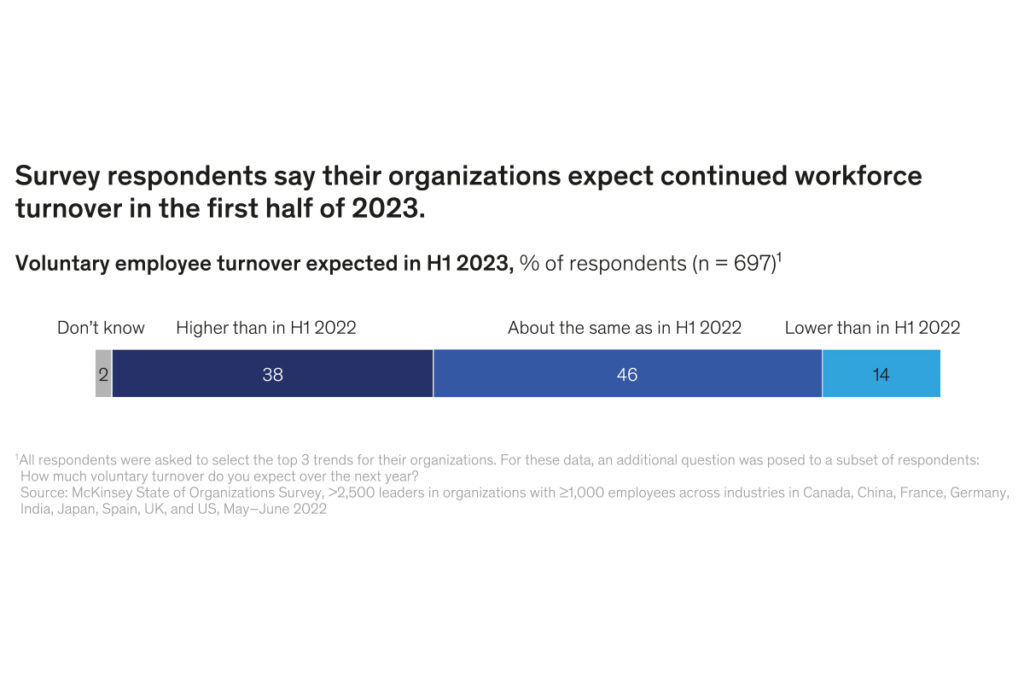
Challenging though this scenario is, it offers an opportunity to tailor their appeal to the unique needs of each particular employee or candidate. This could range from offering flexible hours, a hybrid work environment, better compensation and benefits, opportunities to learn and grow, or something else entirely. These factors are deeply independent for each individual, and getting a finger on that pulse will help executives and organisations understand what they need to do to attract and retain top talent.
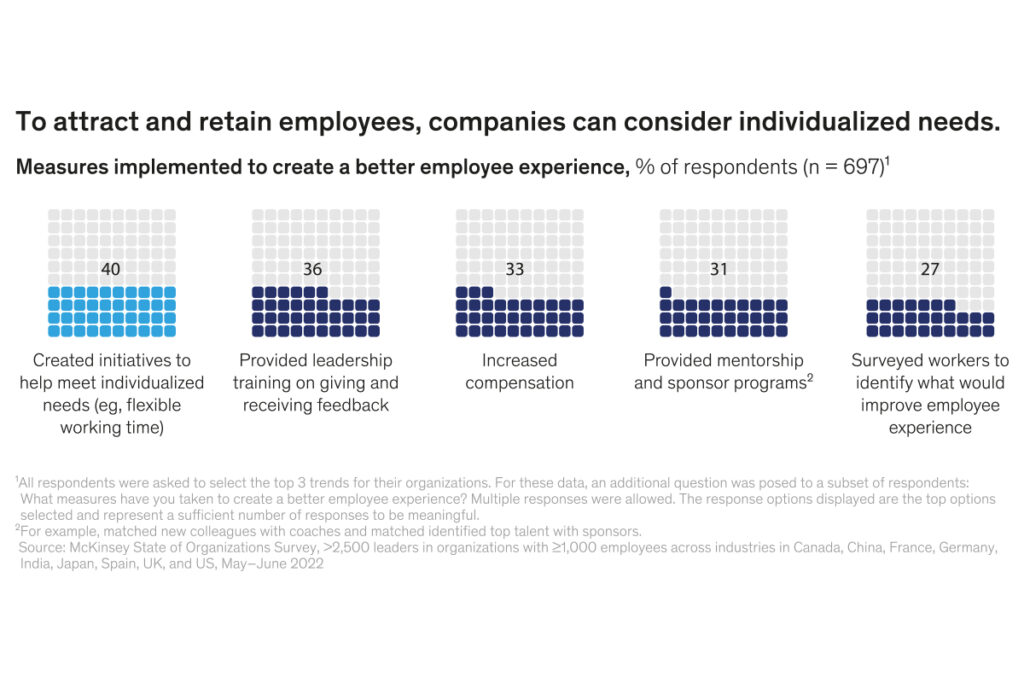
Continuous capability building
As a glut of new technologies hit the market, organisations are scrambling to integrate them into the workplace. But without the right capabilities, these technologies are often not fully leveraged. It thus becomes imperative to first embark on a journey of building capabilities across people and processes before deploying technology. Only then can such technology provide a long-term, sustainable competitive advantage. However, most companies are behind the eight-ball. McKinsey’s State of Organisations Survey saw 90% of respondents deem capability building as something of importance, to be done now or soon. Yet, only 5% felt that they had done so in a satisfactory manner.
The two approaches that can be taken to plugging these gaps could be to either hire from outside or build them internally, but each of them come with their own unique challenges. When it comes to building these capabilities in-house, respondents stated that their top 3 concerns were a lack of time afforded to do so, insufficient support, and a lack of resources.
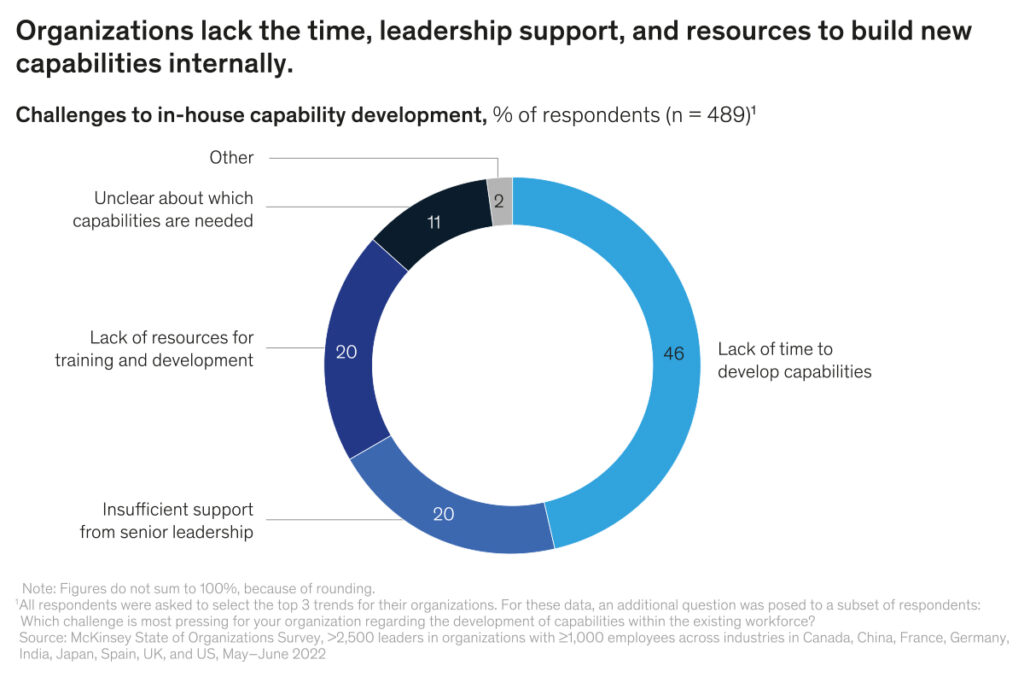
Conversely, when casting their gaze to external hires, respondents pointed out that the talent pool has become increasingly shrunken, and professed an inability to match soaring salary expectations, or an unattractiveness for the right kind of talent.
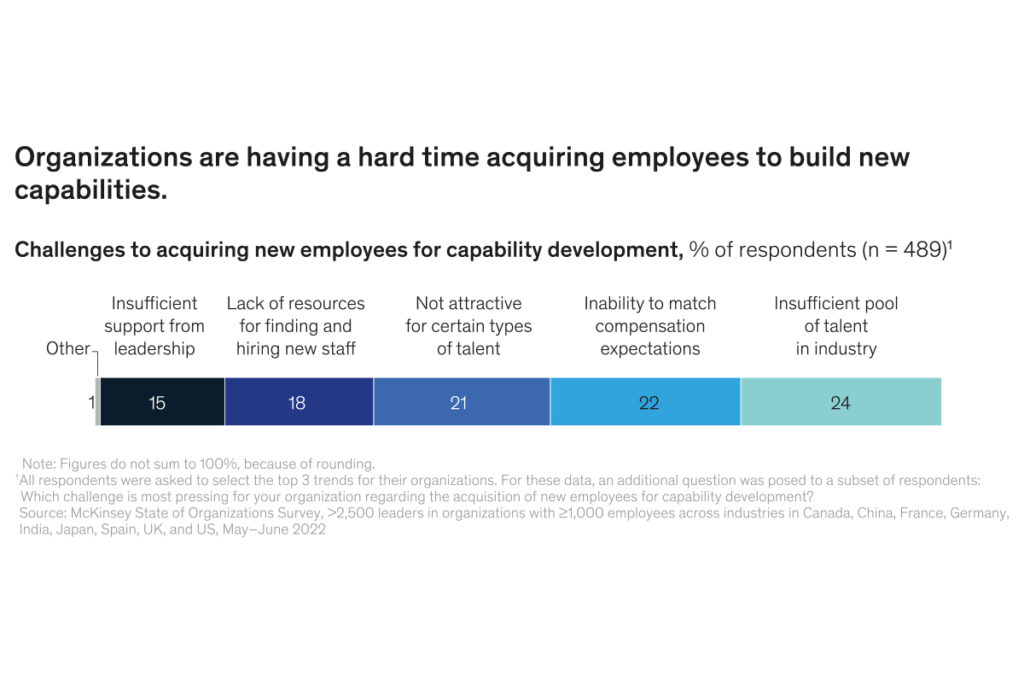
Fixing this calls for a whole-system approach focused on continuous capability building, so that enterprise-wide capabilities permeate the organisational spectrum. This will also afford the right environment for new hires to hit the ground running and hit the heights expected of them, while ensuring the rest of the organisation is running at the same speed.
The tussle for talent
While money might be the lifeblood of a company, its people are its backbone. As the tussle for talent becomes tighter than ever, organisations need to understand how to retain top talent in roles that create the highest value for them and their institutions. This is not a novel idea, but it is certainly in keeping with the mobility of talent and greater pursuit of purpose. And yet, McKinsey research shows that, in many organizations, between 20 and 30 percent of critical roles aren’t filled by the most appropriate people. The greatest challenges in identifying the most critical talent and roles in organisations are the lack of role clarity, a clear talent development agenda, and clarity on the aspirational value of the role in question.
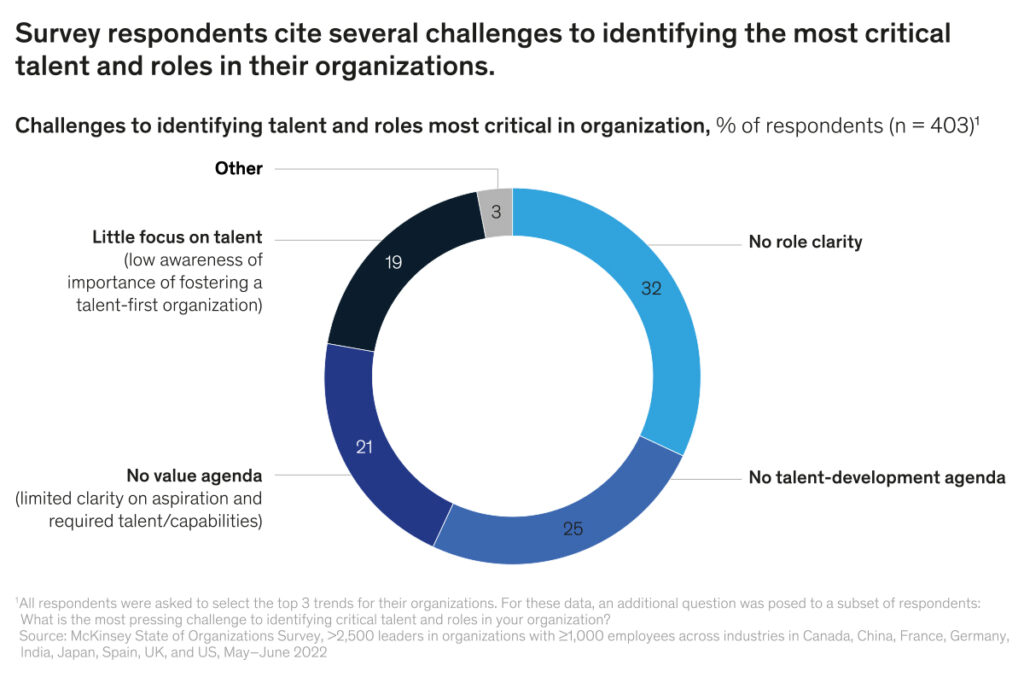
Research has shown that 5% of employees deliver an amazingly outsized 95% of an organisational value, and that mapping these high performers to roles where they are best utilised and reallocating them on a quarterly basis could make these companies 2.2 times as likely to outperform their competitors. With these performers 8x more productive than an average performer, it is critical that their roles be regularly reviewed to ensure the best possible outcome.
Leading the change
With leaders often mired in tackling a multitude of challenges, it often is the case that they miss the forest for the trees. Which is to say, a long-term, macro view of behaviours needed to lead. Be it leading peers, the boardroom, or a team, they must act decisively, coordinating and inspiring change at scale.
Tempting though it may be to go with the tried and trusted, sticking with the familiar might not be the prudent option. There are a glut of new vectors to take care of, such as sustainability, ESG, holistic wellbeing at the workplace, and so much more. This calls for a whole new suite of skills, with a McKinsey survey showing that just 25% of respondents saw their leader as inspirational.
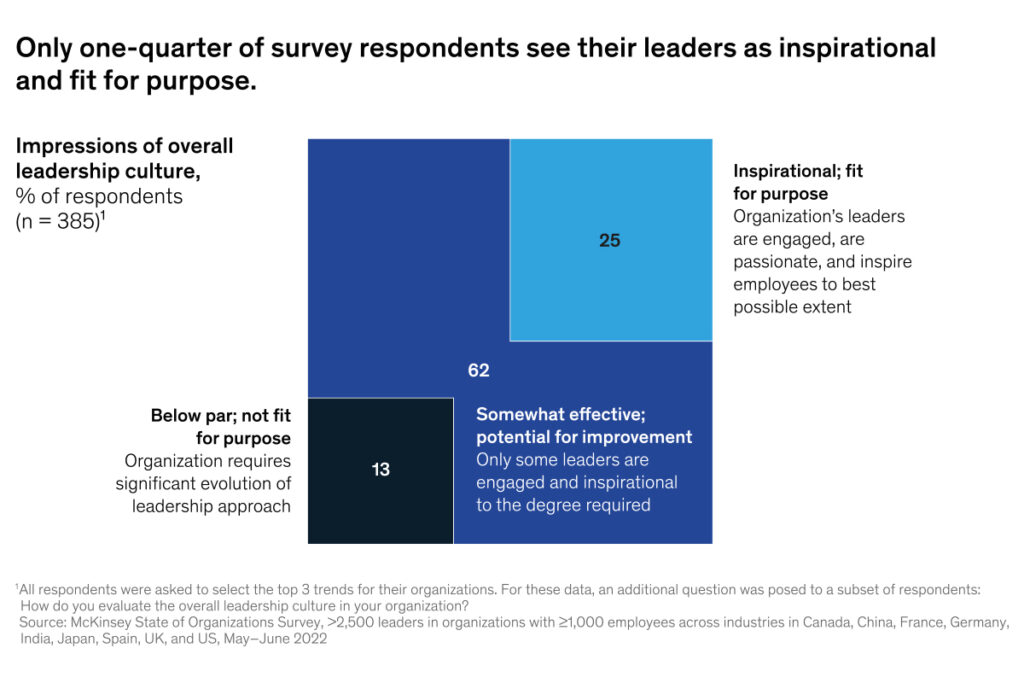
Leading, then, takes on a trifecta of forms; leading the change for the organisation itself, leading peers and teams to their goals, and leading oneself to an evolved mindset. That’s easier said than done, with a lack of incentive, strategies, and leadership training the top 3 hindrances highlighted as hurdles.
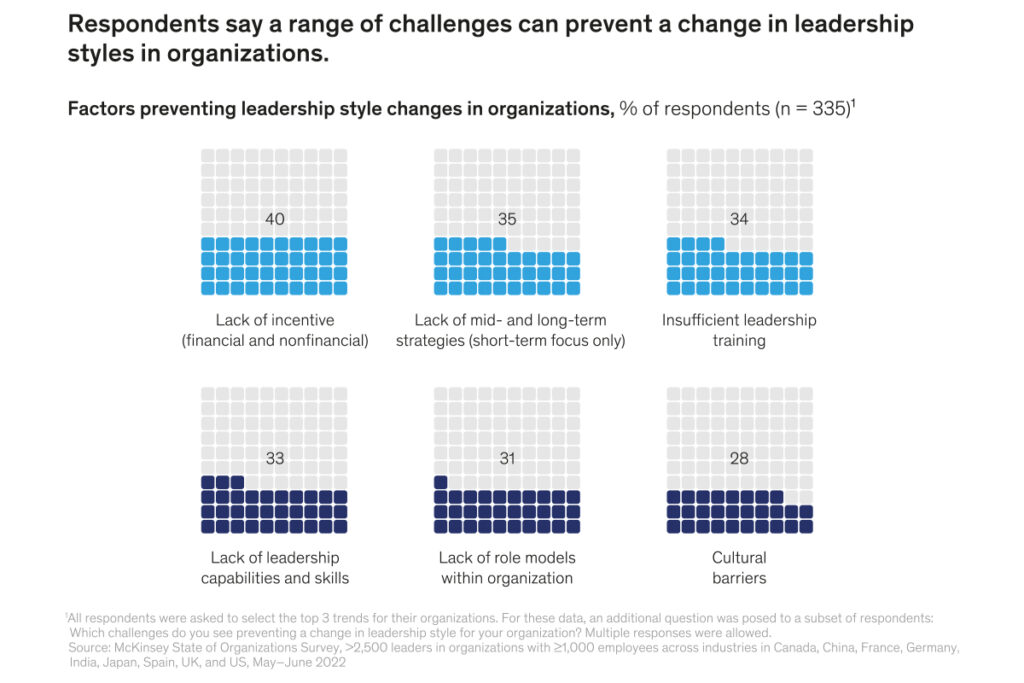
If they are to step things up, leaders must broaden their vision to focus on delivering maximum impact and value while pursuing purpose as their (and by extension the organisational) true north.
Driving DEI
In recent years, DEI has been well and truly in the spotlight, put at the front and center of decision-making and a strategic imperative across the organisation. Very nearly half of the respondents of a McKinsey survey said that their organisation has focused on strengthening their leadership DEI efforts and increased accountability for delivering on DEI goals. 43% have pointed out an increased transparency in promotions and pay processes, while a similar number have stated their organisation has taken measures to tackle bias and discrimination in the workplace.
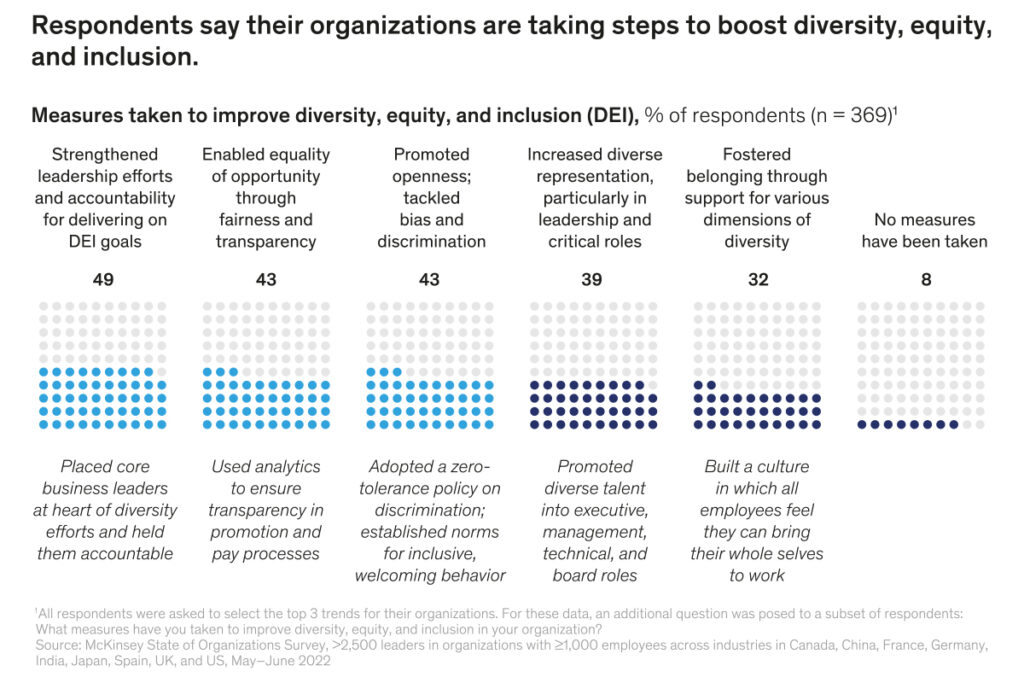
However, gaps exist between professed goals and actions, which is holding back tangible progress. Surveys show that more than 70% of companies polled expressed transformative DEI aspirations, but just 47% have put the mechanisms in place to make this a reality. Measured and applied with focus, DEI can become a potent organisational advantage, helping win the battle for talent, increase diversity, and drive organisational performance.


